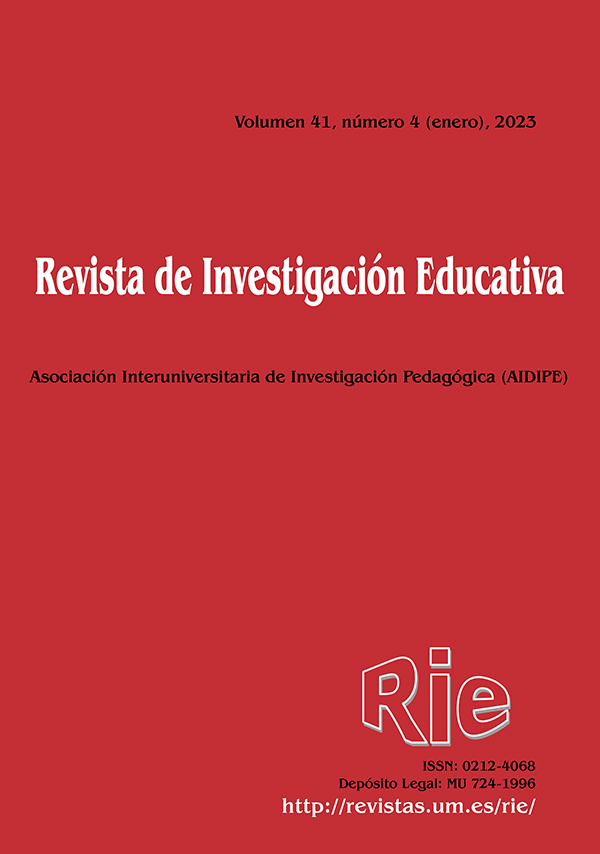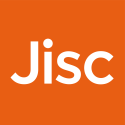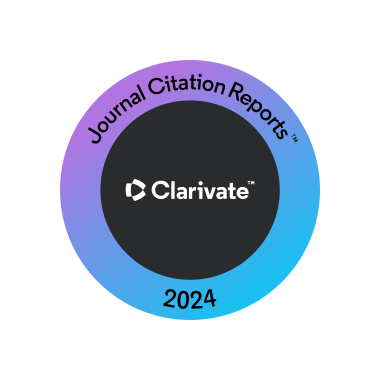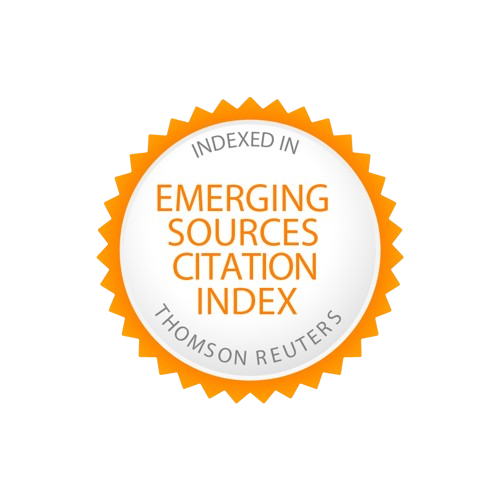Inservice teachers training at university: Competences for bilingual education
Abstract
Bilingual education requires teachers who are effectively trained for that purpose. Relying on this premise, the present research studies the impact that a CLIL (Content and Language Integrated Learning) training program taught by in-service bilingual schoolteachers has on the trainees’ self-perception of their general and specific competences on the matter. The investigation examines a sample of 214 individuals, who are Primary Education preservice teachers (bilingual and non-bilingual tracks), using a mixed methodology comprised of a quasi-experimental quantitative study—in which an adapted version of the Vilkanciené and Rozgiené (2017) questionnaire is used as an instrument—and conducting a qualitative content analysis of three open questions, also derived from the same questionnaire. Results indicate a positive tendency for the implementation of the aforementioned CLIL training program, proving that a regulated training addressed to preservice teachers serves well to foster the acquisition and development of their competences on bilingual education, as it educates them on theoretical and practical matters while focusing on both linguistic and methodological aspects.
Downloads
References
Alonso Díaz, L. (2010). La formación de tutores e-learning o e-formación [Tesis de doctorado, Universidad de Extremadura]. Repositorio Institucional Dehesa, Universidad de Extremadura.
Bazo, P. y González, D. (2017). Política lingüística para la Internacionalización del Sistema Universitario Español. CRUE.
Blázquez, A. (2010). Análisis del bilingüismo. Revista Digital. Innovación Y Experiencias Educativas, 31, 1-9.
Cortina-Pérez, B. y Pino Rodríguez, A. M. (2021). Analysing CLIL teacher competences in pre-service preschool education. A case study at the University of Granada. European Journal of Teacher Education, 1-19. https://doi.org/10.1080/02619768.2021.1890021
Coyle, D., Hood, P. y Marsh, D. (2010). CLIL. Planning tools for teachers. University of Notthingham.
Coyle, D. (2011). Setting the CLIL agenda for successful learning: what pupils have to say, [Conferencia plenaria]. En II Congreso Internacional de Enseñanza Bilingüe en Centros Educativos. Universidad Rey Juan Carlos.
Cubo, S. (2019). La investigación experimental. En S. Cubo Delgado, B. Martín Marín y J. L. Ramos Sánchez (Eds.), Métodos de investigación y análisis de datos en ciencias sociales y de la salud (5ª ed., pp. 235-328). Pirámide.
Delicado, G. y Pavón, V. (2015). La implantación de titulaciones bilingües en la educación superior: el caso de la formación didáctica del profesorado bilingüe de primaria en la Universidad de Extremadura. Educación y Futuro, 32, 35-63.
Delicado, G. y Pavón, V. (2016). Training primary student teachers for CLIL: innovation through collaboration. Pulso, (39), 35–57.
Doiz, A., Lasagabaster, D. y Pavón, V. (2019). The integration of language and content in English-medium instruction courses: lecturers’ beliefs and practices. Iberica: Revista de la Asociación Europea de Lenguas para fines Específicos (AELFE), 38, 151-176.
Escobar, C. (2013). Learning to become a CLIL teacher: teaching, reflection and professional development. International Journal of Bilingual education and Bilingualism, 16(3), 334-353. https://doi.org/10.1080/13670050.2013.777389
Facultad de Formación del Profesorado - Portal de la UEx (6 mayo 2015). Formación del Profesorado impartirá el Grado de Educación Primaria Bilingüe el próximo curso. Onda Campus, Universidad de Extremadura. https://www.unex.es/organizacion/servicios-universitarios/servicios/comunicacion/archivo/2015/mayo-de-2015/6-de-mayo-de-2015/formacion-del-profesorado-impartira-el-grado-de-educacion-primaria-bilingue-el-proximo-curso#.XS8yqugzaM8
Fernández-Costales, A. (2017). Assessing students’ perceptions regarding English medium instruction in higher education. Didáctica: Lengua y Literatura, 29, 43-63. https://doi.org/10.5209/DIDA.57129
Instrucción 6/2019, de la Secretaría General de Educación, por la que se establece el programa de formación educativa “docentes asesores” (programa de formación en metodología bilingüe), en colaboración con la Facultad de Formación del Profesorado de la Universidad de Extremadura, para el curso 2018/2019.
Jover, G., Fleta, T. y González, R. (2016). La formación inicial de los maestros de Educación Primaria en el contexto de la enseñanza bilingüe en la lengua extranjera. Bordón. Revista de Pedagogía, 68(2), 120-135.
Lasagabaster, D. y Ruiz de Zarobe, Y. (Eds.) (2010). CLIL in Spain. Implementation, results and teacher training. Cambridge Scholars Publishing. https://doi.org/10.1017/S0272263112000289
Lozano-Martínez, L. (2017). Los docentes en los programas de educación bilingüe en Cantabria. Elia, Estudios de Lingüística Inglesa Aplicada, 17, 93-123. https://doi.org/10.12795/elia.2017.i17.05
Marsh, D. (1994). Bilingual education and content and language integrated learning. International Association for Cross-cultural Communication (Eds.), Language Teaching in the Member States of the European Union (Lingua). University of Sorbonne.
Marsh, D. (20 de octubre de 2018). El problema de los colegios bilingües es que generan falsas expectativas. El País. https://elpais.com/sociedad/2018/09/24/actualidad/1537811034_517768.html
Martín, P. (2009). Hacia una enseñanza bilingüe. Formación del profesorado. Papeles Salmantinos de Educación, (12), 171-190.
Nieto Moreno de Diezmas, E. (2018). Exploring CLIL contribution towards the acquisition of cross-curricular competences: a comparative study on digital competence development in CLIL. Revista de lingüística y lenguas aplicadas, 13, 75-85. https://doi.org/10.4995/rlyla.2018.9023
Palacios, F. J., Gómez, M. E. y Huertas, C. (2018). Formación inicial del docente AICLE en España: retos y claves. Estudios Franco-Alemanes, 10, 141-161.
Pavón, V. y Méndez, M. C. (2017). Analysing teachers' roles regarding cross-curricular coordination in Content and Language Integrated Learning (CLIL). Journal of English Studies, 15, 235-260. http://doi.org/10.18172/jes.3227
Pérez-Cañado, M. L. y Lancaster, N. K. (2017). The effects of CLIL on oral comprehension and production: a longitudinal case study. Language, Culture and Curriculum, 30(3), 300-316. https://doi.org/10.1080/07908318.2017.1338717
Pérez-Cañado, M. L. (2018). Innovations and challenges in CLIL teacher training. Theory into Practice, 57(3), 1-10. https://doi.org/10.1080/00405841.2018.1492238
Rodríguez-Sabiote, C., Madrid, D., Ortega-Martín, J. L. y Hughes, S. P. (2018). Resultados y conclusiones sobre la calidad de los programas AICLE en España. En J. L. Ortega Martín, S. Huges y D. Madrid (Eds.), Influencia de la política educativa en la enseñanza bilingüe. Ministerio de Educación, Ciencia y Deporte (MECD), 141-160.
Romaine, S. (2001). Consecuencias de la investigación sobre las primeras etapas del desarrollo del bilingüismo en la política sobre educación bilingüe. Revista de Educación, 326, 13-24.
Suárez, M. L. (21-23 de septiembre de 2005). Aprendizaje Integrado de Contenidos y Lengua Extranjera (AICLE): una de las claves para la convergencia europea [Discurso principal]. II Jornadas Internacionales de Innovación Universitaria: El reto de la Convergencia Europea. Universidad Europea de Madrid.
Vilkanciené, L. y Rozgiené, I. (2017). CLIL teacher competences and attitudes. Sustainable Multilingualism, 11(1), 196-218. http://doi.org/10.1515/sm-2017-0019
Yang, W. (2015). Content and language integrated learning next in Asia: evidence of learners’ achievement in CLIL education from a Taiwan tertiary degree programme. International Journal of Bilingual Education and Bilingualism, 18(4), 361-382. https://doi.org/10.1080/13670050.2014.904840
Copyright (c) 2023 Journal of Educational Research

This work is licensed under a Creative Commons Attribution-NonCommercial-NoDerivatives 4.0 International License.
The articles and scientific documents published in RIE abide the following conditions:
1. The Servicio de Publicaciones de la Universidad de Murcia (the publisher) has the property rights (copyright) of all the documents published and allows the reuse under the user’s license indicated in point 2.
2. All documents are published in the digital edition of RIE under a Creative Commons Reconocimiento-NoComercial-SinObraDerivada 3.0 España (legal document) license. These documents can be copied, used, distributed, communicated and explained publicly if: i) the author(s) and its original source of publishing (magazine, publisher and URL of the document) are cited; ii) it is not used for commercial purpose; iii) the existence and the specifications about this license are mentioned.
3. Auto-archive’s conditions. The authors are allowed and encouraged to digitally distribute the pre-print versions (a version before evaluation) and/or post-print (a version that it is already evaluated and accepted to its publication). This promotes circulation and distribution earlier and can increase the citations and significance within the academic community.











